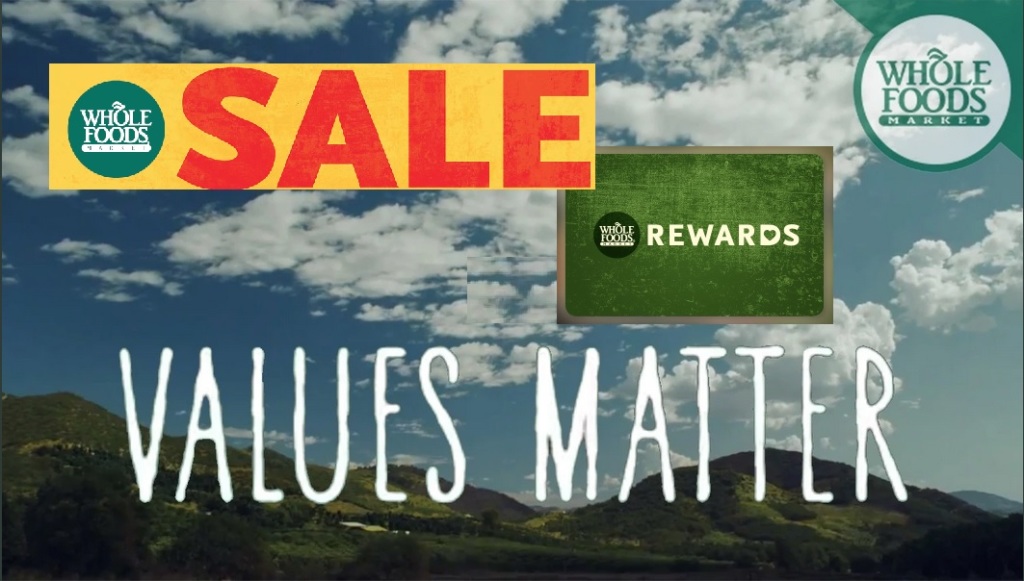
Time was, Whole Foods Market was the place to shop if you wanted to steer clear of the commercial gimmicks employed by mere supermarkets. But no longer. From loyalty program perks, to “new low prices”, to TV ads sandwiched between your favorite shows, the high-end grocery chain is no longer dismissing its rivals’ marketing methods – it’s embracing them.
Straddling the line between common commercialism and shrewd image advertising, Whole Foods’ newest attention-seeking effort is its first-ever national ad campaign. While Whole Foods has advertised locally before, the new campaign is the first to promote the brand as a whole. The campaign will include print ads, billboards and TV commercials that you’ll soon see airing right alongside ads from Whole Foods’ more traditional competitors, such as Walmart’s “Market Basket Challenge” spots and commercials highlighting Kroger or Safeway’s weekly specials.
That’s some downscale company for an upscale grocery chain. But the Whole Foods ads won’t tell you what’s on sale this week. Instead, the focus is on “values” – as in, the socially responsible values that the company holds, and the values that it offers shoppers. For the notoriously pricey Whole Foods, the promise to offer “value” for your money is the closest the ads come to acknowledging that the store is trying to change its “Whole Paycheck” image, in the face of increased competition and disappointing sales.
With “value offerings in every department” throughout the store, “we’ve been reducing expenses and passing along the savings” to customers, Whole Foods’ marketing chief Jeannine D’Addario told the New York Times. “This campaign communicates that value and values go hand in hand.”
Highlighting company values ranging from “responsible ranching practices” to “organic and sustainable farming,” the Whole Foods ads suggest that you get what you pay for. So Whole Foods’ prices really aren’t so bad, the message goes – getting value for your grocery dollar is more important than low, low prices at any cost.
And just in case that doesn’t work, Whole Foods is trying out low, low prices too.
In a test program launched late last month, Whole Foods slashed prices on every item in its produce section – about 400 in all – at the five stores in its home base of Austin, Texas. “Everyday low prices will be in effect,” co-CEO John Mackey told the Austin American-Statesman. But he also promised “a lot more promotions, a lot more radically priced produce.”
Those “radically priced” products include once-99-cent lemons, reduced to 2 for $1. Raspberries regularly priced at $3.49, on sale for $1.50. Most produce items will be priced at less than $2 each or $2 a pound, with sales that can knock the price down by more than half.
“We are going to be more aggressive than we have ever been before,” Mackey said. “We have to be more competitive.”
So as long as Whole Foods is playing the traditional grocery game of lowering prices, adding more promotions and running TV commercials, why not throw in a loyalty program, too?
In another test, this one playing out in Princeton, New Jersey, Whole Foods has introduced its first-ever loyalty rewards program, the aptly-named “Whole Foods Market Rewards”. Unlike traditional grocery loyalty programs, though, Whole Foods’ version won’t merely offer advertised sale prices to cardholders. Instead, enrolled shoppers earn points that can be redeemed for rewards that are “based on individual preferences”, such as a free coffee, free flowers, a gift card or even a cooking class.
“We’ve been spending a lot of time creating a unique program that we believe will deepen our connection with existing customers and appeal to new customers as well,” co-CEO Walter Robb told investors this summer.
Add in manufacturers’ coupons, which Whole Foods accepts, and dozens of store coupons available in store or on Whole Foods’ website, and shopping at Whole Foods just might become more like shopping at a regular old grocery store. Perhaps not exactly what Whole Foods is going for. But with its more traditional competition nipping at its heels, if you can’t beat them at the low prices/big sales/loyalty program game – might as well join them.











Pingback: Whole Foods Market Becoming Another CVS?